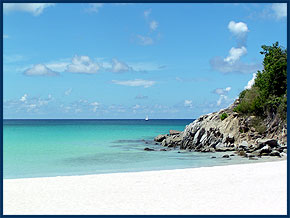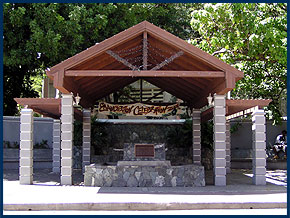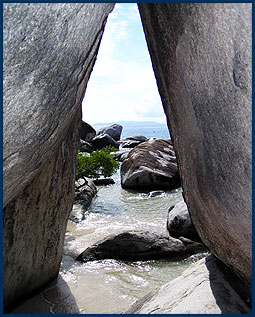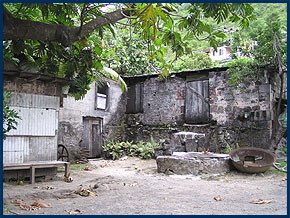| BVI's TORTOLA is a laid-back-to-basics treasure | ||
|
BVIs TORTOLA is a laid-back-to-basics treasure
Theres only one traffic light on the entire island, and when it was introduced a few years back, it was so alien to the local way of life that the government held seminars to instruct the citizens on how to use it. Although the BVI is a British territory, it feels more West Indian than British. Many of the buildings are Caribbean in style. The principle styles of music are reggae, calypso and fungi. And as for the food and drink, they also lean toward West Indian, but if you have a taste for shepherds pie and a pint of ale, no problem.
ARRIVAL: From the deck of a cruise ship, arrival in Road Town, Tortolas major port of call, isnt all that impressive. But once you leave the ship and head inland and upward into the hills, you discover a host of hidden treasures on this lovely little laid-back island. The cruise ship dock accommodates just two ships at a time; if there are more, they must tender in their passengers. A BVI Information Center is steps away from both disembarkation points located in the heart of town, so Tortola itself becomes the terminal. INDEPENDENT SIGHTSEEING: After walking down the gangplank or getting off the tender, its a quick and easy jaunt to the city center. Just past the dock on historic Main Street is where some of Tortolas most interesting shops can be found. Crafts Alive Village, a five-minute walk from the waterfront pier, features handmade West Indian crafts and a local art studio and gallery. Safari buses and taxis offer scenic tours of the islands mountain ridges with awesome views at almost every turn in the road. The most popular of the islands nine beaches, Cane Garden Bay, is a horseshoe-shaped arc of white sand fringed with towering palms. The 25-minute ride to the beach from the cruise ship dock should be about $25 for three passengers. Farther afield are optional excursions to an outer island by ferry, exploring a national park, or a variety of water sports, including diving, snorkeling, windsurfing or kayaking. The islands are making efforts to increase heritage tourism, so the British Virgin Islands Tourist Board recently invested $150,000 to help restore a sugar cane mill on the grounds of the H. Lavity Stoutt Community College. The funds were donated by local artist Reuben Vanterpool. Its anticipated that the mill will be fully restored by the second quarter of 2010. Upon its completions, visitors can learn about the grinding process as well as products of the sugar cane. The BVI Tourist Board also is taking steps to help visitors find their way around the island by installing signs identifying approximately 20 historic landmarks. The erection of the signs began in July in Road Town in an effort to offer information and to point to the 1780 Lower Estate Sugar Works and the VI Folk Museum. The next phases, to be started in 2010, includes signage at the Sugar Mill restoration at the community college and at the Callwood Distillery.
Tortolas special sites of natural beauty and historic significance include the Botanic Gardens, a four-acre refuge in the center of Road Town with a lush array of indigenous and exotic tropical plants.
MUST-SEE ATTRACTION: Aragorns Studio is one of Tortolas finest treasures, located no more than minutes away from the airport at Trellis Bay Village. The local arts center features custom-made copper sculptures and an eclectic collection of exquisite turquoise and blue works of art created by artist/studio owner, Aragorn Dick-Read, plus jewelry, pottery and the handiwork of other Caribbean artisans. WHO GOES THERE: Among the major lines calling on Tortola are Azamara Cruises, Celebrity Cruises, Costa Cruises, Crystal Cruises, Holland America Line, Norwegian Cruise Line, Oceania Cruises, Princess Cruises, SeaDream Yacht Club, Silversea Cruises and Windstar Cruises. |
||
 Of the more than 28,000 people who reside in the British Virgin Islands, 80 percent live on Tortola, its largest island. The Spanish translation for Tortola is island of turtle doves. Apropos, there are no high-rise hotels, no casinos nor fast-food joints of any kind on Tortola, or for that matter, anywhere in the BVI.
Of the more than 28,000 people who reside in the British Virgin Islands, 80 percent live on Tortola, its largest island. The Spanish translation for Tortola is island of turtle doves. Apropos, there are no high-rise hotels, no casinos nor fast-food joints of any kind on Tortola, or for that matter, anywhere in the BVI.  Road as in Road Town, the islands main city, is the nautical name for a protected and safe place to drop anchor. Thats an apt description that explains why the BVI claims the title of sailing capital of the world.
Road as in Road Town, the islands main city, is the nautical name for a protected and safe place to drop anchor. Thats an apt description that explains why the BVI claims the title of sailing capital of the world. OFF THE BEATEN TRACK: Frequent service by ferry boat or by schooner, from Tortola to the nearby island of Virgin Gorda, makes for an appealing half-day excursion. Major attractions include Little Fort National Park, a 36-acre wildlife sanctuary; Nail Bay with ruins of a 19th-century sugar plantation; the Copper Mine, worked by the Spaniards in the 18th century; and Gorda Peak National Park, with astounding views from its highest point of 1,500 feet.
OFF THE BEATEN TRACK: Frequent service by ferry boat or by schooner, from Tortola to the nearby island of Virgin Gorda, makes for an appealing half-day excursion. Major attractions include Little Fort National Park, a 36-acre wildlife sanctuary; Nail Bay with ruins of a 19th-century sugar plantation; the Copper Mine, worked by the Spaniards in the 18th century; and Gorda Peak National Park, with astounding views from its highest point of 1,500 feet. The North Shore Shell Museum displays shells, traditional wood boats and other examples of local culture. Callwood Rum Distillery, housed in a stone plantation-era building, still produces and sells island rum the same way it did more than two centuries ago.
The North Shore Shell Museum displays shells, traditional wood boats and other examples of local culture. Callwood Rum Distillery, housed in a stone plantation-era building, still produces and sells island rum the same way it did more than two centuries ago.